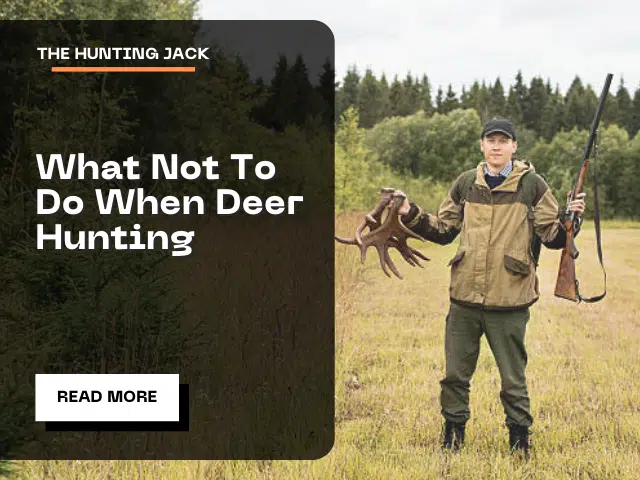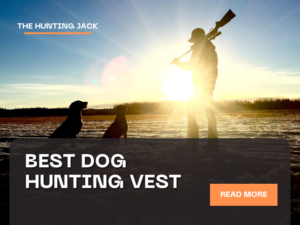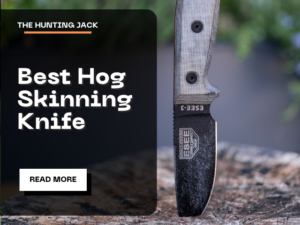Have you invested in quality gear but are yet to land the big bucks? A high-grade rifle and an alluring attractant are essential for stalking deer, but they can only get you so far. To gain wall hangers this deer hunting season, you need to start treating the hobby like an art form.
Some refer to deer hunting as a science. However, I believe it demands too much instinct and creativity to fit into this category. It’s not just a case of ticking a load of boxes – you’ve got to be in tune with the wild and ready to carry out unique actions at all times.
Want to stop making common deer hunting mistakes? In this guide, I’ll highlight what not to do when out on the hunt.
Table of Contents
Toggle1. Forget About Scent Control
For me, this is the number 1 cause of an unsuccessful hunting season. Scent control doesn’t end at buying scentless clothes and boots. A deer hunter needs to continually ensure they’re not giving off any form of scent deterrents.
A deer hunter may be guilty of wearing their clothes in a gas station before heading out on the hunt. Or, a deer hunter may eat lunch onsite and then wash their hands with soap that features a strong scent.
A hunting session is a full-day commitment, so it’s easy to forget about scent control at one or more points throughout the long day. However, forgetting just once could put deer off approaching for the entire hunting session.
Mature bucks are smart creatures and are constantly learning through smells that blow in their direction. To outsmart the buck, you’ve got to ensure you’re feeding no scents into the wind.
To do this, you should start by investing in scentless clothes. You should also use scentless detergents, soaps, and shampoos on the day of the hunt. For those serious about masking their smell, scentless toothpaste is also recommended.
2. Heavily Rely on Trail Cameras
Trail cameras are useful pieces of kit and can be implemented in your approach to hunting. However, watching a trail camera constantly will make you miss the off-camera action. There’s only so much a trail camera can record.
A deer may be passing by but falling just slightly out of the camera’s range. In this instance, you won’t be alert enough to catch it using your own sight. Instead, you’re glued to your trail camera and totally unaware of your surroundings!
Even cellular trail cameras can end up causing you issues. Although convenient, you may slip into the habit of checking trail cameras on your phone constantly. This reduces the amount of focus you can give to your peripheral vision. In the end, it may end up causing you to miss the perfect chance to shoot big bucks.
In addition to all of this, some hunters make the mistake of persistently fidgeting with the camera itself. If the initial angle they’ve chosen is not showing any deer on screen, they’ll move the camera in a different direction. By doing this, you’re spreading your scent more than necessary. Plus, you’re making more noise. This all contributes to scaring off nearby deer.
3. Hunt in the Same Spots
As we said in the introduction, hunting is about being prepared to make unique moves. While routine is important in terms of preparation, the wild does not necessarily follow a specific structure. You can’t expect a deer to keep showing up in the same spot.
While deer behavior can sometimes appear to follow a set pattern, these routines can change daily. Each generation of deer will likely use the land slightly differently. While some will follow the same route each season, you’ll find plenty of other deer carrying out unique movements.
You need to stay alert to new deer habits. Don’t base your hunting position on an area where you witnessed buck activity two months ago. Deer alter their routes based on what they smell. Breeding opportunities, security, food, water, and cover can all influence how a deer travels. To stay ahead of the deer, you’ve got to be in tune with their changing habits.
4. Neglecting Scouting (Or Scouting Too Much)
The best way to keep on top of the changing behaviors of big-buck deer is to dedicate sufficient time to scouting. Scouting is the preliminary activity of getting out into the wilderness and seeking deer activity. It consists of reading signs and making observations.
When scouting, one of the main things to look out for is tree rubbing marks. Bucks most commonly rub trees around the rutting season. This is done to control their aggression and mark territory. Other things to look out for include finding evidence of bedding and deer travel routes.
It is also a good idea to tactically establish mineral sites and food plots as you scout. In the pre-rut season, this will help you attract mature bucks to your chosen hunting zone.
While scouting is an essential part of deer hunting, you should avoid overdoing it. Marching around the woods constantly will obviously scare deer in the area. You can scout for whitetail behavior all year round. However, you shouldn’t do it in the same location more than a few times per season.
If you’ve just started hunting in a brand new location, we’d recommend dedicating the first few days to scouting out the area. This way, you’ll be able to gauge if it’s even worth hunting in the new location or not.
5. Ignoring Doe During Rutting Season
When hunting deer, you probably want to get a mature buck over a doe. Bucks make better wall hangers. However, it’s much more tactical to focus on the does during the rutting season. By this, we mean locating where the does sleep, eat, and walk.
With your eyes on the doe, all you have to do is wait for the big bucks to turn up. You can wait on the bucks to come to you rather than you to them.
If you’ve lost track of the does during the rutting season, try scouting for them around midday. Deer are particularly active around midday all year long, but particularly in and around rutting season. At lunch, you’ll likely catch deer on the move when out scouting.
6. Not Taking Hunting Pressure Into Account
Throughout deer season, deer hunters need to talk to each other. While the sport can get competitive at times, it’s important to converse with other hunters to find out where and how much they’re hunting. Hunting pressure reflects the level of hunting going on in a specific area. With more hunters in a specific area, more pressure is put on the deer population.
High hunting pressure changes how deer act. When a herd establishes that an area is dense with hunters, the herd will move on to an area where they feel safer.
If you’re hunting on private land, determining the level of hunting pressure is easy. Private landowners will have a record of recent hunting activities on their property. From this, you can gauge how much pressure has been put on the deer population in the area.
When hunting on public land, there’s no real way of determining pressure levels unless you communicate with other hunters. For this reason, I’d recommend striving to make good relations with all deer hunters in the area. Other hunters, too, would benefit from the information you provide them.
7. Forgetting About Access Routes
When setting up a hunting spot or hanging tree stand, you need to think of your access points. Your entry and exit routes determine how stealthy you can be when at the start and end of your hunting session. If your entry point is too conspicuous, you risk scaring off the deer before you even get properly started!
You should be able to walk to and from your hunting spot without drawing attention to yourself. The best means of doing this is to establish an access route that doesn’t come close to deer bedding areas. If you pass too close to a bedding area, you’ll most likely alert the deer to your presence. An ideal access and exit route runs along a dry creek bed.
Of course, you should also leave your vehicle parked far away from your chosen deer hunt spot. A major deer hunting mistake is driving as close as possible to your treestand location. Walking can be difficult, especially if you have bulky equipment. However, it’s necessary if you want to avoid alerting deer to your presence.
8. Forgetting to Rattle
Upon spotting a deer that is out of your shooting range, most hunters seem to forget the power of a grunt call. Although many hunters carry all kinds of attractant noises, using a rattle or grunt noise is by far the most effective, especially when you spot a deer in the distance.
Naturally sociable, bucks are constantly listening for calls from their kind. As soon as they pick up the authentic rattle of another deer, they’re happy to walk hundreds of yards to find the source. So, when bringing a deer closer to you, don’t forget to rattle!
However, it’s important not to overdo it when it comes to calling deer. Constantly rattling – especially when there’s no deer in sight – will cause confusion and suspicion within the local herd. Rather than drawing them towards you, reckless deer calling will likely drive bucks and doe away from you.
9. Not Using the Weather to Your Advantage
The idea that deer don’t move on windy days was prevalent in the deer hunting community for some years. However, recent Penn State University studies found that deer are more active in these weather conditions. Not hunting on cold or windy days is, therefore, one of the biggest deer-hunting mistakes!
So, while deer are out moving more than ever in the wind and the rain, many hunters choose to stay home. You could take advantage of this by hunting on these bad weather days.
The only weathers that will put deer off moving are strong gales and snow storms. So, it would be wise not to hunt on these days – for your own safety, too. However, before and after strong gales and snow storms, deer will be moving around more than usual.
Bucks can sense when changes in the weather are due to occur and hunt as much as possible beforehand in preparation. After sheltering, deer will also likely move around more than normal to make up for their inactive time.
10. Not Dressing Appropriately
Deer hunting requires a lot of time and patience. It also requires a lot of standing around in various terrains and conditions. Not dressing appropriately is one of the biggest deer-hunting mistakes because it can diminish your stamina for the hunt. With less energy, you lose sight of your target and generally have a worse hunting trip than you would have had otherwise.
Make sure to invest in an on-season outfit as well as an off-season one. Have lightweight gear ready for the summer and insulated and waterproof clothing and boots prepared for the winter.
FAQs
Should you follow deer trails?
You shouldn’t walk directly on a deer trail. Although it’s useful to identify deer trails when out scouting, you could put a deer off returning to this trail by walking down it. It’s not the biggest of deer hunting mistakes you could make, but it definitely doesn’t help.
How far can a deer hear you when walking?
A deer can hear human footsteps within a 400-yard radius. This is why you should keep your walking to a minimum while deer hunting. Be careful not to make too much noise when scouting the wilderness, as it could scare deer off.
Final Thoughts
Committing too many deer hunting mistakes could jeopardize your entire hunting season. Even just committing one could kill your chances of coming close to a doe or a buck for several days. Deer are sensitive to noises and smells, and you can use these both to your advantage.
Be sure to control your scent, diversify your hunting areas, dress appropriately, and follow the other rules highlighted in this article.
For more tips to become a better deer hunter, we have plenty of guides to help so check them out next!



